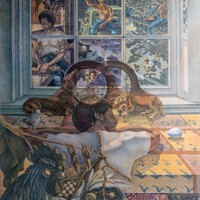"My Life After the Death of My Mother" by Bertram Samples

Bertram Samples’ mural, My Life After the Death of My Mother, features three layers. Samples painted a younger version of himself, asleep on a yellow and red checked table that is decorated with green birds and plants in the middle of the composition. To the artist’s left is a small gray bird and on his right is a slightly cracked egg. In the foreground of the mural, there is a rooster surrounded by corn, alongside fetuses at various stages of development.. Behind, and overlapping with, Samples’ head is a clock that gradually combines with two small dogs.Behind the clocks is a window with six picture panes. In the upper and lower left frames, the artist holds his mother’s hand on her deathbed, while he is comforted by unseen figures. Above his head, a marionette and police officer’s face loom menacingly. In the upper middle frame, a teenaged Samples is shirtless and sitting on a truck with his fist raised. In the lower middle, the artist holds a torch amongst a scene of moonlit clouds. The upper right frame shows teenaged Samples sitting in a tree, while below him a younger version relaxes in the grass next to a dog.
Bertram Samples’ mural captures the essence of his experiences as a young black man in Houston. The artist’s style is deeply rooted in traditional storytelling with an allegorical perspective. The mural unfolds like a dream, with each panel on the window above the central figure, who is asleep on a table, revealing a constellation of scenes from Samples' youth. The right panes depict a harmonious coexistence with nature and animals—a reflection of Samples' memories growing up in Houston's Fifth Ward with his grandparents. It's a nostalgic journey into his family and community’s affinity with nature and with the animals that surrounded him in his youth - especially dogs. Likewise, the foregrounded rooster and corn seem to highlight Samples' intimate knowledge of the land.
Contrastingly, the left and upper middle panes above the figure delve into the harsh realities of Samples' experiences, unveiling the struggles of racism in the South, the loss of his mother, and identity crises he faced as a young black man. The scenes portray unsettling encounters with prejudice, including the haunting specter of police pursuit. Yet, amidst the turmoil, Samples has described feeling an outside protective force, a powerful undercurrent that carried him through the challenging times of his early adulthood.
Samples' mural is a time capsule of the 1970s, capturing the tumultuous atmosphere of the Vietnam War, protests, and Black power movements that shaped the artist's perspective. The mural serves as a visual memoir, chronicling the transformative era that fueled Samples' artistic expression. In interviews, Samples has identified education and schooling as a pivotal turning point in his early life. In his mural we see this symbolized by two clocks outlined above the sleeping figure. These clocks not only mark the passage of time but also represent the shift between worlds—between childhood and adulthood, innocence and maturity, and harmonious existence and conflict.
Learn more:
Virtual tour of TSU Hannah Hall Murals | United Way Women's Initiative. (youtube.com) - see 21:20
This program is made possible in part by a grant from Humanities Texas, the state affiliate of the National Endowment for the Humanities.
